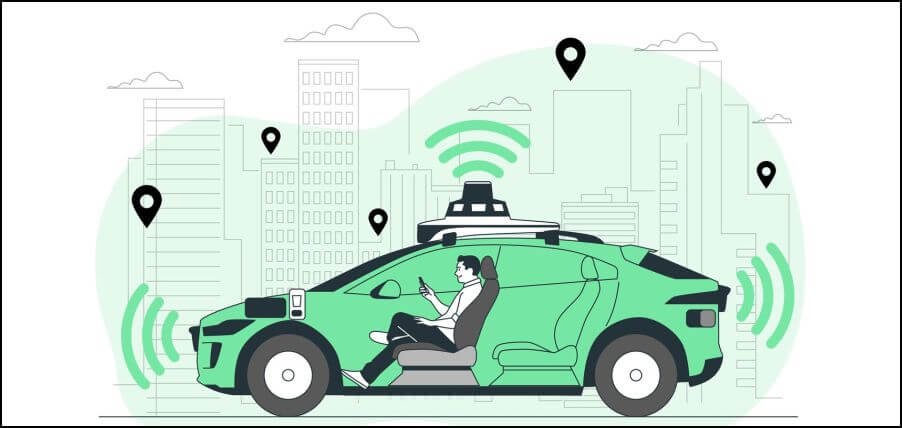Despite general scepticism, the market for driverless vehicles is growing at robust rates. Last year, this segment of the auto industry was valued at nearly GBP 121.5 billion, and the projection for its growth is above 30 per cent through 2030. Concerns about the safety and reliability of these vehicles focus mainly on the precision of their navigation and decision-making systems.
Maps and geocoding systems like those provided by egon.com are essential for these new vehicles. Indeed, they are the first systems that come to mind when most people think of autonomous vehicles (AVs). However, many other systems and components are necessary for a safe driverless experience. Learn more about those systems and components here.
Beyond the Streets
There has been a lot of hype about driverless cars lately as top carmakers and big tech companies—including Tesla, General Motors, Volkswagen, Microsoft, and Google—have jumped into the AV field. Other companies, such as Nuro, have been created to focus solely on autonomous vehicles for delivery.
Despite the big names behind this industry, there aren’t many AVs around yet. In fact, there were only 17,000 AVs worldwide in 2022, with market projections pointing to about 127,000 units on the roads by 2030. Indeed, mass production is a big challenge for AV carmakers, and regulations can vary widely from one country to another, explaining the somewhat slow expansion of driverless cars. Nevertheless, the technologies for a foolproof AV are evolving at staggering speed.
Crucial Navigating Tools for Driverless Vehicles
Humans are fallible, but replacing them behind the wheel is not easy. It takes a wide range of cutting-edge technologies to make vehicles operate as if a well-trained and judicious human driver would be operating them. Here are some of the most essential tools for this task.
GPS
Drivers are already familiar with the global positioning system, or GPS. It’s used for maps and provides real-time information about traffic and road conditions, suggesting the best routes. It’s an essential tool for AVs, as it gives the vehicle’s exact location and works with other automated systems to drive safely and efficiently.
LiDAR
Light Detection and Ranging (LiDAR) sensors create accurate 3D maps of a vehicle’s surroundings using a laser to calculate objects’ exact distance and size. This tool is very handy for drivers and indispensable for driverless cars, as it warns about obstacles and uneven terrain. This system can scan its surroundings and create high-resolution images, allowing for precise recognition of pedestrians, cyclists, animals, and other obstacles of any shape or size.
Radar
Radar sensors can guide the vehicle where cameras cannot, such as during weather conditions with reduced visibility. Radar systems are based on radio waves, and they complement other detection systems around the vehicle, like cameras and LiDAR sensors, for enhanced precision.
Cameras
Cameras are essential for AVs for obvious reasons. Radar and LiDAR sensors are precise, but only cameras can provide visual data of the vehicle and its surroundings. Cameras are also used for traffic sign recognition, road markings, lane tracking, and object detection. More importantly, they have image-processing algorithms to feed the decision-making system.
Communication Systems
Fully functional AVs need more than sensors and cameras to drive by; these vehicles also need to communicate with each other. Communication systems won’t steer the vehicle, but they will exchange critical information with neighbouring cars in real-time. In this context, there are two main communication systems:
- V2V: Vehicle-to-vehicle communication systems exchange intentions, movements, and hazards and can help improve road safety and coordination.
- V2I: Vehicle-to-infrastructure systems can recognise road signs, traffic lights, and othe traffic-related objects. They can also provide route suggestions on the go based on a driver’s decisions and traffic conditions.
Additionally, autonomous navigation systems rely on cloud-based platforms, remote monitoring and control. Those technologies allow for remote diagnostics, improved efficiency, and regular software updates that are vital to guarantee adherence to safety protocols, regulations, and traffic guidelines.
Automated Decisions
Collecting vast amounts of data from cameras and sensors would be pointless without software that can analyse it and decide its outcomes. This involves advanced computing science, data analysis, and complex neural networks.
AI and Machine Learning
Machine learning algorithms are, quite literally, the brains of the entire automated system. They were created to make predictions based on vast volumes of data. Deep neural networks can even recognise images and combine information from different sensors to adapt to changes as they occur.
Additionally, ML-based systems use reinforced learning techniques, ensuring the algorithms will keep learning new outcomes based on drivers’ input, optimising the decision-making process as a result.
Path Planning
Path planning algorithms do much more than finding the shortest route between two points. They consider road rules and capacity, speed limits, traffic conditions, and obstructions like accidents or road maintenance work.
Decision-Making
Decision-making algorithms handle braking, acceleration, speed control, and lane changing. Additionally, they’re equipped with safety protocols that allow for automated collision avoidance responses to improve safety.
Privacy and Safety Concerns
Despite the impressive development of AV technology in the past few years, many challenges remain to overcome. A recent poll among drivers in North America, Europe, Asia, and Australia showed that 30 per cent of interviewed drivers would never buy an AV.
Unfortunately, the scepticism isn’t unfounded. Apart from a host of road accidents involving malfunctioning AVs, there are also concerns about privacy and data safety. Will AVs be vulnerable to cyberattacks, for instance? In this case, a cyberattack isn’t only a threat to someone’s privacy but also to everybody’s safety around the vehicle.
That’s why AV companies continue to invest in solid cybersecurity systems, but that’s still not enough. There’s still room for improvement regarding more transparent data policies, privacy regulations, and industry standards for cybersecurity.
Conclusion
Driverless technologies are evolving fast, and their improvements in issues like safety and reliability have been tremendous. Sensors and decision-making tools can still be further honed, but big techs and carmakers are investing heavily in them.
However, until a fully reliable and commercially viable driverless vehicle hits the market, conventional vehicles can benefit from semi-autonomous driving assistants and advanced safety features created for AVs.














